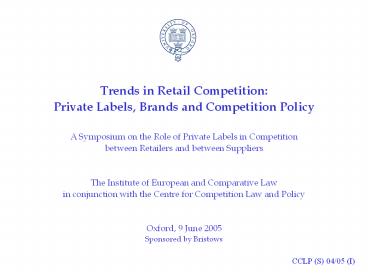Trends in Retail Competition: - PowerPoint PPT Presentation
1 / 19
Title:
Trends in Retail Competition:
Description:
... The Growth of Chains Evolution of Large Formats Dedicated Distribution ... of Presentation The Retail Revolution The Nature of Change The ... – PowerPoint PPT presentation
Number of Views:174
Avg rating:3.0/5.0
Title: Trends in Retail Competition:
1
- Trends in Retail Competition
- Private Labels, Brands and Competition Policy
- A Symposium on the Role of Private Labels in
Competition - between Retailers and between Suppliers
- The Institute of European and Comparative Law
- in conjunction with the Centre for Competition
Law and Policy - Oxford, 9 June 2005
- Sponsored by Bristows
CCLP (S) 04/05 (I)
2
Private Label
- Their Role for Retailers
- Their Impact Upon Competition
Part I
3
Structure of Presentation
- The Structure of Grocery Retailing
- The Integration of Grocery Retailing
- The Role of Private Label
- How Private Label is Developed
- The Impact Upon Competition
4
The Retail RevolutionThe Nature of Change
- The Growth of Chains
- Evolution of Large Formats
- Dedicated Distribution Systems
- Retail Chains as Retail Brands
5
The Retail RevolutionConsequences of the Nature
of Change
- Growth of Chains
- Large Formats
- Integrated Dedicated Distribution
- Retail Brands
- Increased buying power
- Focus on price as competitive weapon
- Decline in number of small stores
- Shift to Out of Town
- Exclusive Sites
- The Application of I.T.
- Control of Retail Stores
- Speed Frequency of Replenishment
- Decline of Wholesaling
- Differentiation by Format Location
- Private Label
- Loyalty Programmes
6
Retail Concentration
Country Market Share HHI
Netherlands 95 2394
Sweden 95 2990
Austria 93 2211
Denmark 84 2502
Norway 84 2500
Switzerland 84 2535
France 83 1619
Finland 83 2529
UK 79 1355
Germany 76 1216
Belgium 72 1128
Portugal 54 671
Spain 51 462
Greece 45 509
Italy 31 285
Median 83 1619
Market Concentration 2002 The Top Five
Retailers
7
Retailer Scope -The Virtuous Circle
Price Competition
Growth
Efficiency
Asset Investment
Supply Chain Dominance
Gross Margins
Private Label Fresh/chilled
Differentiation
8
Integration - Up-stream
I N F O R M A T I O N I N T E G R A T I O N
INTEGRATED STOCK CONTOL
SCANNING
DAILY DELIVERY
H.Q.
CENTRALISED BUYING
SUPPLY CONTRACTS WITH PRODUCERS
9
Consequences of IntegrationRef. Private Label
- Supply Chains Exclusive to Individual Retailers
- Collapse of Wholesaling
- Direct (and Potentially Exclusive) Contracts with
Producers - Farmers
- Manufacturers
10
The Model is Changing
Stage 1 - The Classic Structure of Distribution
Consumers (Shop in several stores)
Stores (Can purchase from different wholesalers)
Wholesalers
Suppliers (Supply all wholesalers)
11
The Model is Changing
Stage 2 - The Erosion of Horizontal Competition
Consumers (Shop in one stores)
Stores (Supplied by chain RDC)
TESCO
ASDA
SAINSBURY
Distribution Centres
Suppliers Branded Suppliers try to supply all
chains. Chains seek exclusivity from P/L
Suppliers
12
The Model is Changing
Stage 3 - The Emergence of Vertical Silos
Consumers (Shop in one stores)
Stores (Supplied by chain RDC)
TESCO
ASDA
SAINSBURY
Distribution Centres
Suppliers Branded Suppliers supply some chains.
P/L Suppliers
13
The Role of Private Label for Retailers
- Differentiation Reduces Price Competition
- Customer Loyalty
- Higher Margins
- Consumer Value
14
Cost DifferencesBrands vs. Private Label
Suppliers Cost Saving 10.6
Lower Supplier Margin 18.8
Retailers Purchase Saving 29.4
Lower Retail Price 19.3
Higher Retail Margin 10.1
Source UK Competition Commission
15
DifferentiationPer Cent Sales in Private Label
Products
Secodip
16
How Private Label is Developed
- Product and Packaging Specification is Developed
Jointly with Potential Supplier - Suppliers Asked to Tender for the Cost of Supply
- Product Responsibility (Adherence to Spec, Safety
etc) Passed up the Chain e.g. Sudan Scare - Concept of Vendor Assurance Contrasts with
Concept of Brand Ownership
17
How Private Label is Developed In Store
- Benchmark the Brand Leader
- Look-a-likes
- Category Segmentation
- Space Allocation
- Selective Listing of Brand Leader SKUs
18
Cloning I
0.99
1.28
19
Cloning II
1.59
1.81































